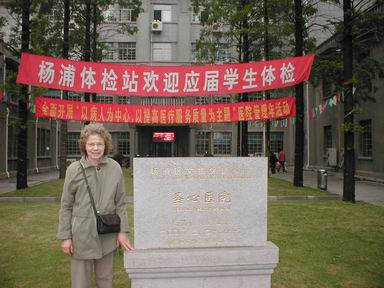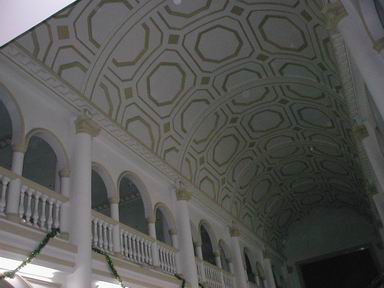 Imagine it’s May 1945, the war in Europe has ended, and the Americans have captured (parts of?) Okinawa, the tropical island in the very south of Japan. Allied air raids are starting over Shanghai.
Imagine it’s May 1945, the war in Europe has ended, and the Americans have captured (parts of?) Okinawa, the tropical island in the very south of Japan. Allied air raids are starting over Shanghai.
Your husband has been sent by truck with your belongings, and you are with your two daughters, aged 3 and 6. You’re being marched by Japanese soldiers part of the way from one internment camp to another. You haven’t been out into the streets for over 2 years. You’re probably suspicious, afraid. Where are you really going? Will you continue to be treated tolerably, as you have been the rest of the war? Will you and your family survive?
On Saturday morning, we went to visit the site of an internment camp where my mum, her sister and their parents had been held hostage by the Japanese at the very end of the war. This was Yangtzepoo camp (on modern Yangshupu Lu), the second camp they had been in after Yu Yuen Road camp. Judging from the meter on our taxi, the march from the Bund to the new camp was 6km.
To our amazement, we found the camp not only intact, but thriving. It’s near the river, the Yangpu Bridge flyover arching past along Ningguo Road. The photo above is of Rosemary in front of its heritage architecture plaque. It’s called the Sacred Heart hospital, as it was before the war. The guard was very friendly, and let us wonder all round – it seemed a modern, clean, hospital. Well sign-posted in Chinese and English. The photo below is a detail from the ceiling in the main building. I took lots more photographs which we’ll put up somewhere when we get back.
 We walked back, following the route of the family’s forced march 61 years before. It’s now a run down corner of Shanghai with tiny cramped shop/house hybrids and street food. We walked past the waterworks, which is a fantastic set of old crenelated buildings, well maintained, re-pointed and landscaped with flowers. You can’t get in, it is very much still in active use.
We walked back, following the route of the family’s forced march 61 years before. It’s now a run down corner of Shanghai with tiny cramped shop/house hybrids and street food. We walked past the waterworks, which is a fantastic set of old crenelated buildings, well maintained, re-pointed and landscaped with flowers. You can’t get in, it is very much still in active use.
So, what was the new camp like? It was worse than the old one. Cramped, and left in a terrible state by the Japanese soldiers who had been using it as a barracks. The soldiers had moved into the old camps the internees had just left. They were afraid that the Americans were about to bomb them. Fortunately, the war ended and the internees were released before any bombing.
My grandfather always said that the atom bomb had saved the family’s lives. If the war had dragged on for even a short while longer, the Americans would have almost certainly bombed the camp, as they thought it was still a Japanese barracks.
So, this leaves me in the unenviable position that if it weren’t for the nuclear bombs, which killed over a hundred thousand people and introduced the world to its most devastating weapon, then I wouldn’t exist.
I understand that this is the official story. However, there is documentary evidence that this claim is a false, although it is politically convenient to both sides.
http://www.zmag.org/content/showarticle.cfm?ItemID=8457
>>>This hour-by-hour examination of why and how the Japanese leadership decided to surrender finds that it was the Soviet declaration of war on August 8th – and not the Hiroshima bomb on August 6th or the Nagasaki bomb on August 9th – that led to surrender. As Hasegawa notes in his conclusion, “Justifying Hiroshima and Nagasaki by making a historically unsustainable argument that the atomic bombs ended the war is no longer tenable.”
Maybe we should get the book.
From the US side this lie requires you to assume that:
(a) The US believed that the fascist government of Japan gave a flying f*** for the lives of 200,000 people in the civilian cities of Hiroshima and Nagasaki.
(b) The government of the US was negotiating in good faith to avoid testing this amazing new weapon to end all weapons which they had hurried to finish in time on live people. Had they done so, the war may well have ended sooner.
(c) The fact that Japan was already militarily defeated, as evidenced by the fact that there were no obvious better targets, such as a naval fleet.
Anyways, now we have documents from both sides of the conflict. The decision to use this bomb was very contentious in the US at the highest levels. The story which you have repeated now is like an account of the invasion of Iraq that makes no mention of “Weapons of Mass Destruction”. Don’t do it again.
Yep – and when I went to Hiroshima you mentioned another zmag article. My apologies for getting carried away this time, and thanks for the reminder. I started by quoting my grandfather, who died in the mid 1970s, and so without the newer evidence reasonably believed the atomic bomb ended the war.
I still favour the interpretation that the American war machine wanted to use the bombs publically in war time, as a show of might to the world.
I was interned from February 1943 to April 1945 in Yu Yuen Road Camp, Shanghai, and then in Yangtzepoo Camp from April to August 1945, and was 14 years old when WW2 ended. We internees accepted the official verdict at the time that the end of the war with Japan came about as a result of the use of the atomic bomb on Hiroshima and Nagasaki in August, 1945. However since then there has been evidence that the war might have been over much sooner if Japan’s overtures to end the conflict had been heeded. Instead, it can now be argued,the end of WW2 was deferred to enable the atomic bomb to be tested on the two cities as live targets and to demonstrate to the world the horrendous effect that the nuclear bomb had when used on civilians. Today, I hold the belief that the war could and should have ended sooner. Many more lives would have been saved and they would have included all those Allied and Japanese military and civilian casualties which took place after the end of the war in Europe.
Interesting to read about the x-ray film. Do you know when they found it?
While I think that Rodney Stableford has a very good point (indeed, the Japanese ‘overtures’ were only asking that the emperor be spared upon surrender, which is exactly what happened), my axe to grind is the timing of the bombing of Nagasaki. We (the allies – I am a Briton) bombed Nagasaki only 4 days after Hiroshima. That does not seem to me to be an appropriate amount of time, if one’s objective really is to bring about peace.
I wonder when the x-ray film was found.
The results of an Internet search tells me that the x-ray film was found on August 10th, a day *after* the citizens of Nagasaki were vapourised.
http://joumon-juku.com/23/English/09_e.html
I can’t see how Nagasaki can be justified by any stretch of the imagination.
I think that we talk about “Hiroshima and Nagasaki” as if they were one event (even the wikipedia page is unified) to hide the clear horror that was Nagasaki.
I have very recently become aware of the website:
http://www.japanfocus.org/-Tsuyoshi-Hasegawa/2501
relating to the essay written by Tsuyuoshi Hasegawa, Professor of Modern Russian and Soviet History, University of California, entitled :
The Atomic Bombs and the Soviet Invasion: What Drove Japan’s Decision to Surrender?
I do recommend anyone interested in the subject to read it.